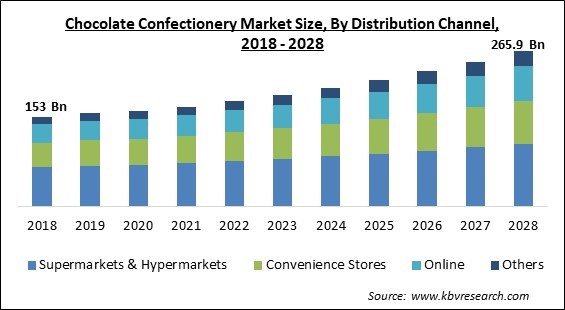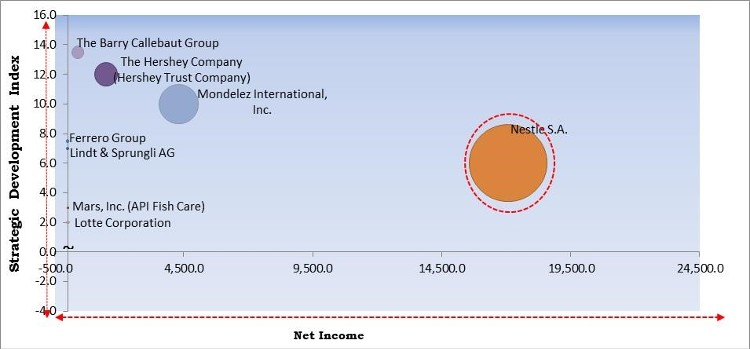The Global Chocolate Confectionery Market size is expected to reach $265.9 billion by 2028, rising at a market growth of 6.7% CAGR during the forecast period.
The most common options in the chocolate confectionery sector include oranges, citrus fruits, nuts, and especially walnuts.
Chocolate confectionery product innovation is becoming increasingly popular as consumers want more innovative, healthful, and environmentally friendly products. Manufacturers gain from nuts in all three of these areas. Moreover, nuts such as walnuts and almonds, as well as their derivatives, are components that complement chocolate beautifully, delivering a variety of nutritional and sensory benefits. Additionally, a significant proportion of confectionery product customers chose healthier alternatives in the previous year. Consumers are no longer satisfied with any chocolate candy, instead, they seek for products that are good for them as well as the environment.
Vegan and plant-based diets have become increasingly popular in recent years, and this is inspiring new product introductions in the chocolate confectionery business. Chocolate makers are betting on milk-free products, or products created with dairy alternatives, such as milk or beverages based on plants and nuts like almonds or pecans, to cater to the preferences, demands, and requirements of a broad spectrum of consumers. It is important to remember that in several markets, a huge proportion of chocolate consumers still prefer milk chocolate. This fact will continue to augment the launch of new vegan chocolates, along with many of those profiles entering the lactose-free chocolate trend in the next few years.

The COVID-19 pandemic caused severe harm to the worldwide economy with significant damage to various businesses irrespective of their sizes. Due to the rapid spread of the infection, governments all over the world were compelled to impose lockdown in their countries, which lead various companies and manufacturing facilities to a temporary closure. Moreover, governments also enforced several travel restrictions, which caused a major disruption in the worldwide supply chain of various goods and services. The COVID-19 pandemic also impacted the chocolate confectionery market.
Chocolates are primarily consumed and connected with seasonal festive occasions in many countries throughout the world, fueling their global demand. Chocolates have become a favorite dessert at religious gatherings and special occasions like Christmas and Easter. Every year, consumers demand more inventive chocolate flavors. Seasonal launches have increased significantly in developed countries around the world in recent years. To capitalize on the expanding demand, the leading market players are heavily investing in research and development facilities, distribution networks, and appealing packaging. Millennials' increasing demand for craft, customized, and luxury chocolates are propelling the chocolate confectioneries industry forward.
In recent years, there has been a tremendous increase in the demand for a premium or specialty chocolates, particularly in developed markets with an increasing trend anticipated in the coming years. Consumer demand for information about the origins of ingredients used in chocolate confectioneries is encouraging manufacturers to provide the complete detail for the product on its packaging. The growing popularity of clean-label and organic products for general health and wellness has boosted the demand for dark and sugar-free chocolate treats with higher cocoa content. In the coming years, surging public awareness about labor rights is projected to increase demand for fair-trade chocolate.
The chocolate confectionary market is being impacted by the rising prevalence of lifestyle-related health disorders, such as obesity and diabetes, linked to excessive sugar consumption. A considerable number of people all over the world are being diagnosed with diabetes every year. In addition, there is a huge proportion of people that are also being diagnosed with obesity, which can give the emergence to various other diseases further. The majority of confectionary items are high in calories. A modest treat can supply the body of a consumer with a lot of energy. As a result, eating sweets lead to the consumption of more calories per day resulting in obesity.

Based on Type, the market is segmented into Milk, Dark, and White. In 2021, the milk segment acquired the highest revenue share of the chocolate confectionary market. Milk chocolate is being preferred by a considerable number of people all over the world, which is also owing to the growth of this segment. Moreover, many companies are introducing new products along with clean labels like vegan, organic, and certified Kosher to enhance their existing product assortment due to the growing developing preference for milk type categories.
Based on Distribution Channel, the market is segmented into Supermarkets & Hypermarkets, Convenience Stores, Online, and Others. In 2021, the online segment acquired a significant revenue share of the chocolate confectionary market. One of the key elements propelling product sales via online channels is a shift in consumer buying behavior. Companies are increasingly offering products through online platforms as consumers' preferences for them grow. Many firms have been breaking into the worldwide market using online platforms, which have lower entry hurdles and allow products to be supplied by online corporations or third-party distributors like Amazon.
Based on Product, the market is segmented into Molded Bars, Chips & Bites, Boxed, Truffles & Cups, and Others. In 2021, the molded bars segment procured the largest revenue share of the chocolate confectionary market. Molded chocolate bars are the most popular type of chocolate in the world. Because of their convenient size, they are popular among consumers. Product introductions by major manufacturers are propelling the growth of the segment.
| Report Attribute | Details |
|---|---|
| Market size value in 2021 | USD 170.9 Billion |
| Market size forecast in 2028 | USD 265.9 Billion |
| Base Year | 2021 |
| Historical Period | 2018 to 2020 |
| Forecast Period | 2022 to 2028 |
| Revenue Growth Rate | CAGR of 6.7% from 2022 to 2028 |
| Number of Pages | 227 |
| Number of Tables | 384 |
| Report coverage | Market Trends, Revenue Estimation and Forecast, Segmentation Analysis, Regional and Country Breakdown, Competitive Landscape, Companies Strategic Developments, Company Profiling |
| Segments covered | Product, Type, Distribution Channel, Region |
| Country scope | US, Canada, Mexico, Germany, UK, France, Russia, Spain, Italy, China, Japan, India, South Korea, Singapore, Malaysia, Brazil, Argentina, UAE, Saudi Arabia, South Africa, Nigeria |
| Growth Drivers |
|
| Restraints |
|
Based on Regions, the market is segmented into North America, Europe, Asia Pacific, and Latin America, Middle East & Africa. In 2021, Europe accounted for the largest revenue share of the chocolate confectionary market. The increasing growth of the segment is attributed to the rising consumption of chocolates in the region. In recent years, France and Belgium have experienced significant growth. Increased supply of artisanal chocolates, ongoing taste improvements, and in-store promotions are driving the regional market growth. Consumers want high-quality products that are both healthy for the environment and their health. During the forecast period, the robust food and beverage industry in Europe is expected to fuel market growth in this region.
Free Valuable Insights: Global Chocolate Confectionery Market size to reach USD 265.9 Billion by 2028

The major strategies followed by the market participants are Product Launches. Based on the Analysis presented in the Cardinal matrix; Nestle S.A. is the forerunners in the Chocolate Confectionery Market. Companies such as Mondelez International, Inc., The Barry Callebaut Group, The Hershey Company (Hershey Trust Company) are some of the key innovators in the Market.
The market research report covers the analysis of key stake holders of the market. Key companies profiled in the report include Ferrero Group, The Hershey Company (Hershey Trust Company), Lindt & Sprungli AG, Mars, Inc., Mondelez International, Inc., Nestle S.A., The Barry Callebaut Group, Lotte Corporation, Lake Champlain Chocolates, and CÉMOI Group.
By Type
By Distribution Channel
By Product
By Geography
The chocolate confectionery market size is projected to reach USD 265.9 billion by 2028.
Rising demand for specialty chocolate product are driving the market in coming years, however, health concerns regarding chocolates growth of the market.
Ferrero Group, The Hershey Company (Hershey Trust Company), Lindt & Sprungli AG, Mars, Inc., Mondelez International, Inc., Nestle S.A., The Barry Callebaut Group, Lotte Corporation, Lake Champlain Chocolates, and CÉMOI Group.
The expected CAGR of the chocolate confectionery market is 6.7% from 2022 to 2028.
The Supermarkets & Hypermarkets segment acquired maximum revenue share in the Global Chocolate Confectionery Market by Distribution Channel in 2021, thereby, achieving a market value of $107.0 Billion by 2028.
The Europe market dominated the Global Chocolate Confectionery Market by Region in 2021, and would continue to be a dominant market till 2028.
Our team of dedicated experts can provide you with attractive expansion opportunities for your business.

